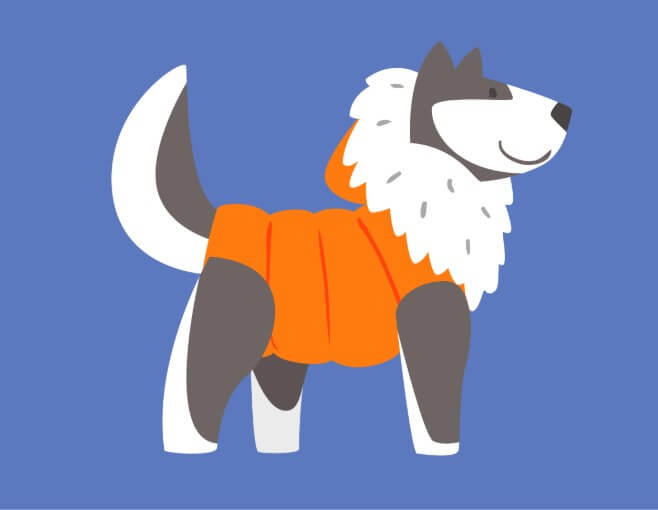Huskies’ thick, full coats often lead people to believe that this breed of dog can only thrive in very cold climates, but Siberian Huskies are a very adaptive dog breed that thrive in a variety of climates all over the world.
So, what temperatures can Huskies handle?
Siberian Huskies can handle temperatures as cold as -75 degrees Fahrenheit (-60 degrees Celsius). The unique coat of the Husky enables this breed to live in both cold and warm climates. Appropriate precautions and considerations of overall dog health should be taken before exposing any dog to extreme temperatures.
Historically, Huskies were bred and used for long distance travel as sled dogs through sub-zero temperatures. Their dense double fur coat provided the necessary insulation to maintain a warm body temperature while exposed to extreme cold temperatures.
Today, Huskies can be found from warm coastal Florida, to snow covered Alaska, and all over the globe. While Huskies can thrive in both cold and warm climates there are many considerations to keep in mind before exposing a dog to either climate.
Limited Grooming Required
While Huskies do shed, overall they require little grooming.
The best brushes can help with the shedding process and can help to limit the amount of dog hair floating around your home. Brushing can also prevent painful matting of long fur.
When brushing your Husky, start with the undercoat.
A wide tooth brush or comb is best for this layer. Then, use a regular brush to go through the top coat. This process helps to ensure both layers of fur are well groomed and mat free.
Baths can be given as needed if fur becomes matted or if your dog decides to take a roll in the mud. If your dog is in need of a bath, make sure to fully rinse out all product used on the fur.
Baths should be given sparingly to avoid removing naturally occurring oils and prevent drying out the skin.
Although it may seem like a good idea to shave a Husky’s coat during warm summer temperatures to eliminate heat retention, this is strongly discouraged and can prove to be very dangerous for the health of the dog.
Husky fur is created to withstand both cold and hot temperatures.
Shaving the coat off during warm seasons removes both the protective top coat as well as the undercoat. Elimination of the dog’s hair exposes their skin to dangerous UV rays and can result in painful and damaging sunburn.
A Double Husky Coat for All Seasons
Huskies have a unique double coat that protects their skin and body temperature in both cold and warm climates. The double coat is comprised of two layers:
- The top coat
- The undercoat
The Husky top coat of the fur provides benefits in both cold and warm seasons.
As the name states, the top coat is on top of the undercoat. This layer of straight hair provides protection to the undercoat and provides an added layer of heat insulation during the cold seasons.
During the warmer seasons, the top coat helps to repel water and allows air flow to help cool off warm body temperatures. The top coat also acts as a layer of protection from harmful exposure to sun rays which may cause sunburn and damage to the skin.
The Husky undercoat grows thick during the colder seasons.
This layer is made of soft, crimped hairs. These hairs work as a layer of insulation to maintain warm body temperatures in cold weather. The protection from the top coat creates the thick double layer coat for extra insulation and warmth.
Husky fur from both the top coat and undercoat sheds constantly throughout the year.
During the spring and fall the hair sheds in larger quantities, primarily from the undercoat, to provide a coat that has the appropriate amount of warmth for the season.
The springtime undercoat shed allows for a lighter, cooler coat to come in for the summer season, while the shed in the fall allows for a thick, warmer coat to grow in for the cooler winter season.
Keeping Huskies Warm in Cold Climates

Huskies can withstand temperatures of up to -75 degrees below Fahrenheit, but that is not to say that all Huskies can withstand extreme temperatures.
…or that Huskies can withstand cold temperatures for long periods of time without appropriate precautions in place.
If your Husky will be spending the majority of their time outdoors during cold weather it is vital to provide the appropriate care to ensure their health and wellbeing.
During cold weather, a dog’s metabolism will burn through energy more rapidly as they work to keep their body temperature up.
It’s important to make sure your dog is getting a diet rich in both carbohydrates and fat to provide a healthy and balanced diet that can sustain their nutrition and maintain a healthy body temperature. Make sure to consult your veterinarian if you are unsure about the quality of your pet’s diet.
Shelters are another critical item to provide your Husky if they will be spending time outdoors in cold weather.
The shelter should be big enough for the dog to move around, but small enough that their body heat will be preserved in the shelter. It is a good idea to provide a door on the shelter as another method to retain heat during cold temperatures.
Instead of using blankets that may freeze when they become wet, straw is a good option for shelter bedding. The straw provides a comfortable cushion off the floor of the shelter and is another tool to retain heat.
Precautions for Huskies in Warm Temperatures

Huskies can do just as well in warm temperatures as they do in cold temperatures if they are provided the right resources.
In warm weather, Huskies should spend time in a cool spot such as a garage, basement, or indoor air conditioned space. On extremely hot days it may be best to play with your dog indoors and limit lengthy trips outdoors.
If your Husky needs daily walks or frequent exercise outdoors, it is best to do this before sunrise or after sunset when temperatures may be cooler.
Huskies spending time outdoors in warm temperatures should always have access to areas of shade at all times. Shade from trees and dog shelters can provide a much needed reprieve from hot, direct sun exposure and help to cool off warm dogs.
Small toddler pools filled with cold water can be a great tool and fun activity for your Husky to cool off from warm temperatures.
Water should always be provided and easily accessible for dogs at all times. This is especially important on warm days.
If dogs are exposed to extremely hot temperatures, do not drink enough water, or exercise for too long they may experience dehydration and overheating. Below are a few symptoms of these conditions provided by The American Kennel Club.
Symptoms of Dog Dehydration and Overheating:
- Lethargy
- Vomiting
- Disorientation
- Stumbling or Collapse
- Dry Nose and Mouth
If your dog is showing signs of dehydration or overheating, consult with your veterinarian immediately.
Related Questions
Yes, it is okay for Huskies to sleep outdoors if they are provided adequate protection from the elements. In cold temperatures a shelter should be provided that is big enough for the dog to move but small enough to retain heat. A door and straw bedding are also helpful to provide insulation. In warm temperatures, shade and water should be provided at all times.
Huskies were originally bred to live in sub-zero temperatures, but adapt well to both cold and warm temperatures. Husky fur is able to provide protection to the animal in both cold and warm temperatures.
In extreme cold temperatures Husky paws may get cold if exposed to cold, snow, or ice for long periods of time. Boots for dog paws may help to alleviate cold as well as snow and ice buildup on the paws during time spent outdoors.